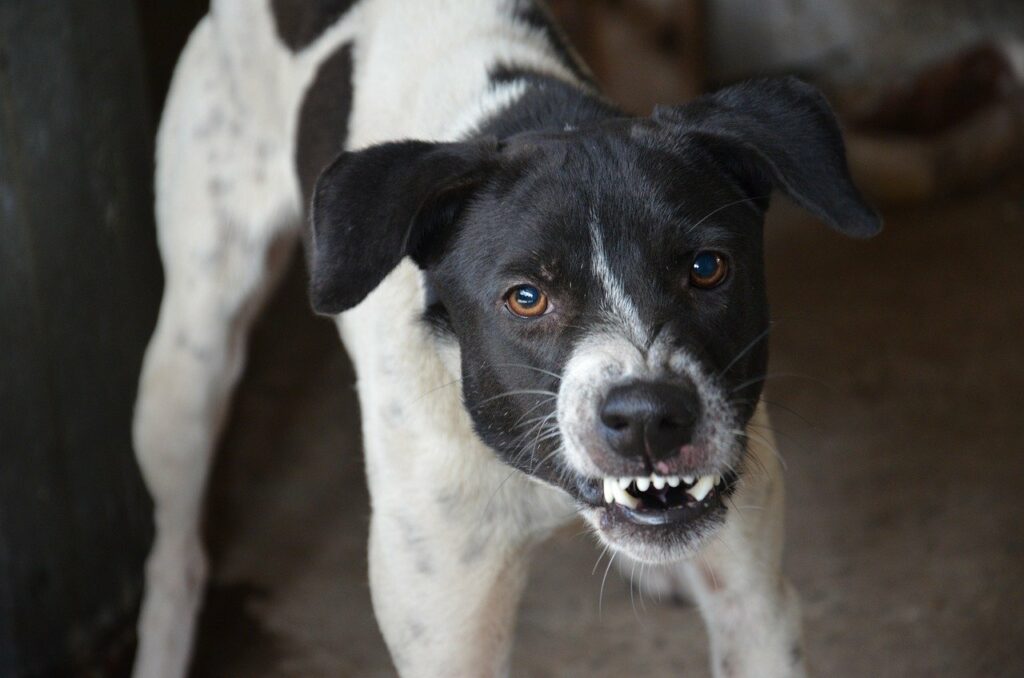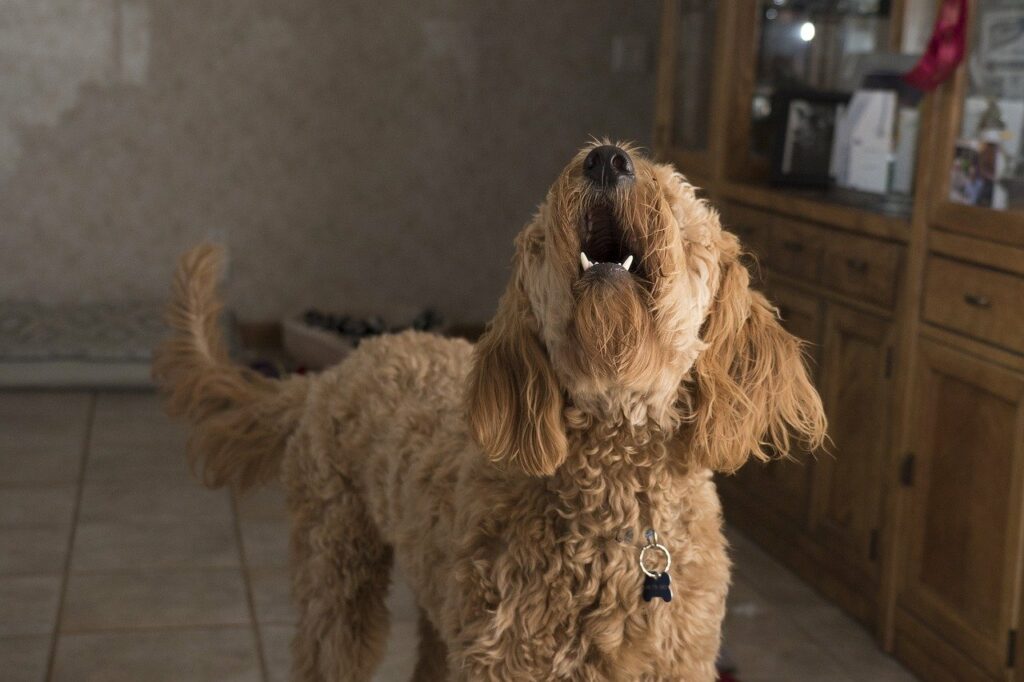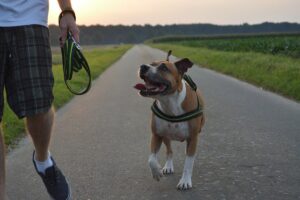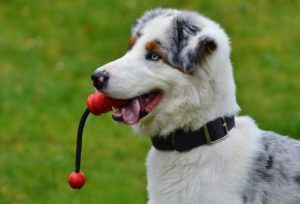Being a dog owner carries a lot of responsibility. And despite the fact that dogs are wonderful creatures, there are aggressive dogs as well. Aggression can arise from a variety of circumstances but it is always dangerous as things always escalate rather quickly in such situations. This is not that common, but even if you encounter such behaviour, be it in your own dog or other dogs, there are ways to handle it. But make sure that you note the very first, even subtle, sign of aggression.

Aggressive dog behaviour can be explained in two ways: a behaviour connected with an attack or with an impending attack. So, it also includes being rigid, still, growling, baring teeth, all the way to attacking another dog. But let’s first address a common misconception: it’s not just larger dogs or the so-called “dangerous breeds” that are prone to aggression: any dog is prone to aggression given a certain set of circumstances. And the only difference between an aggressive Chihuahua and an aggressive pit bull is that the bigger breeds can cause proportionately bigger damage.
Although this is quite a problem that cannot be solved overnight, you can seek help of a professional trainer and do quite a few things to help your dog stay calm.
So, why are dogs aggressive?
Aggression can be directed towards an animal (another dog or a cat), a person, but also on sounds or just objects. And you cannot make a plan to deal with it before you know the reason behind it. Usually, aggression comes in the following forms:
- Territorial – protecting the house from intruders
- Protective – protecting you or other members of its ‘pack’ from others
- Possessive – dogs can get very protective when it comes to food, their chew toys, or any object of value, the so-called resource guarding.
- Fear – the dog gets fearful and retreats, but once cornered has no other choice but to attack.
- Defensive – when a dog attacks in defence. But, usually, dogs give a clear indication of wanting to be left alone before attacking, i.e. turning their head away. So, the other dog literally asked for it…
- Social – dogs who are not socialised properly may exhibit aggression towards other dogs.
- Frustration – when dogs are on a leash, they feel inhibited as they are not able to ‘react’ as their instinct tells them, so they bark (not to say act out) to compensate for this limitation.
- Redirected direction – dogs can unfortunately get aggressive to the person who tries to break off a dog fight.
- Pain-caused – when dogs are in pain or injured, they can show signs of aggression – surely, you’ve seen Beauty and the Beast. The poor thing is literally just in pain but cannot express it…
- Sex-related – when two male dogs or two female dogs fight for the attention of their ‘chosen one’. This is the one case which can be easily sorted by neutering and spaying.
- Predatory – when the instinct to chase like a hunter kicks in, there’s really no warning. And this can really be dangerous if there’s a child around as it will only take a second for these dogs to turn from Dr. Jekyll to Mr .Hyde so you don’t want this scenario on your mind.
How to stop aggressive behaviour?
It cannot be emphasised enough how essential it is to find the underlying cause of aggression. So, you need to make a note of any slightly aggressive behaviour your dog exhibits and the circumstances surrounding it. It will take time, patience, consistent, and most likely, help of a professional like Cesar Millan, especially if your vet has ruled out a medical problem.
Sometimes and unfortunately, aggressive behaviour can be a consequence of a neurological disease or even cancer. There is even an association of professional dog trainers. The trainer will help you set out a plan. The main idea is to use positive reinforcement which is to reward your dog for desired behaviour. The guideline is to avoid punishments as this strategy usually backfires and can even escalate the aggression as the dog may even feel the need to defend itself from you.

What should you do with a dog that’s fighting with other dogs or even cats?
Rule number 1, keep your dog away if you know this is the case so he or she doesn’t snap. By remaining calm, give him or her treats to reward the desired behaviour. After many treats and gradual progress, start decreasing the distance between your dog and ‘strangers’ whoever they are, using a LOT of positive reinforcement along the way. The idea is for your dog to learn that other dogs, cats or people “equal” treats as he or she will be getting a ton every time it remains calm in their environment. The “abundant treats for positive reinforcement” method of course works for all kinds of situations, as food has ‘magical properties’ when it comes to dogs.
When training is not enough…
When you are not able to handle such situations, i.e. if your dog is aggressive towards children and you have children, unfortunately the safest decision is to consider giving your dog a new loving home with owners who will have the patience to heal his or her aggression. Please note that learned aggression can usually be cured but hereditary aggression nor the one due to lack of early socialisation can only be controlled and hopefully contained.
Consider medication…
In some instances, unfortunately, dog owners must consider resorting to medication. And especially dogs that are aggressive due to fear may need medication to overcome the problem as we all know how paralysing and powerful fear can be. Putting it simply, a dog under a lot of stress, anxiety or fear is just incapable of learning new things. So in this case, just try to think of the medication as helping your dog deal with the fear. And the good news is that most likely, he or she will only need the medication temporarily. So try to remember that when you’re scared of by hearing your vet suggest Prozac, Xanac and other not-at-all naive medications.
Keeping your pooch safe from aggressive dogs
Not to scare you, but attacks from other dogs can happen in an instant. So you need to be prepared at all times. First, you need to know your own dog: is he or she calm and laid back or does it like to ‘challenge’ other dogs? This of course does not mean that your dog is aggressive, but it makes your dog to be a likely target.
Don’t expect other dogs are ‘nice and cute’
Watch other dogs, but avoid making direct eye contact as this is ‘an invitation’. You can never trust an unfamiliar dog, not because dogs aren’t wonderful creatures but because you simply don’t know how their owners trained them so don’t expect every dog will behave nicely.
Stay calm and keep your dog on a leash
No matter what you see, you need to stay calm as not only your dog but any dog in your surrounding will sense fear and your own dog will only become more guarded to protect its owner. Keeping your dog on a leash at least allows you to ‘control’ the situation at all times. So, if you see a ‘dangerous’ dog on the way, just make space by going around. Speak to your dog to soothe him or her, as supposedly you included voice commands in your training as well.
Avoid danger by ALWAYS being alert
When you see another dog off-leash, be even more alert. Maybe the dog is not even aggressive, but just by running ahead of its owner (and ‘flying around’) can seem threatening to your dog, and we cannot emphasise enough how quickly things can escalate. If you see ‘a pack’, just immediately change the direction you are headed off to. Don’t run, as this can only create unnecessary panic for your dog and cause attackers to attack, but just get yourself and your dog out of their way as soon as possible.
If…
If things go south, standing in between them BEFORE they start fighting is the first thing to do. Second, you want to have a ‘defence-weapon’ with you. If you cannot bring yourself to possibly hit a dog as you would use something like a club to swing in front, opt for a pepper spray or a very loud air horn to distract the attacking dog and hopefully, ease the attack scenario. But by all means, do your best to avoid an encounter if at all possible.
On a brighter note
We stumble from fear when we hear “dog aggression” that we often forget that we live in an aggressive society. Not to go further and say that we created it, but even if we didn’t invent the term ‘violence’, we certainly innovated on it. And dogs are just simple loving creatures who ‘absorb’ our stress and feelings as unlike us, they are not able to put things in a context. We were given the gift of a ‘mind’ and yet we don’t use it as much. Odds are that your dog will be a wonderful, calm and loving pet. But even if you note some sort of aggressive behaviour, YOU CAN DEAL WITH IT as long as you react on time and in the right manner. And going further by eliminating stress and negativity from your every day life, as that is bound to help your dog as well. But whatever you do, don’t give up- your dog would never give up on you!









